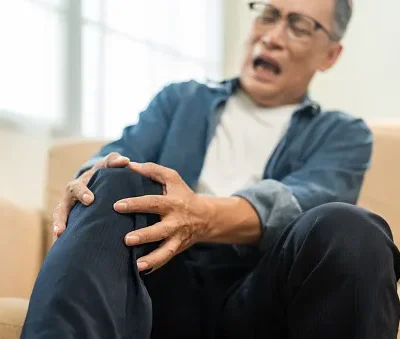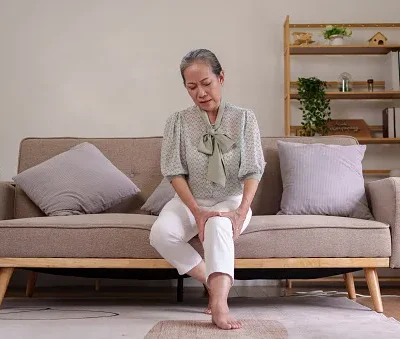
Encouraging family members and friends to help with your care can ensure that you manage your condition well and remain functionally independent as long as possible. Stress can be a trigger for certain types of arthritis, especially rheumatoid arthritis. For people with arthritis—especially inflammatory types—following some simple dietary rules may help alleviate symptoms.
Arthritis can be a challenging condition to deal with, especially for our elderly loved ones like Grandma. As her knees are affected, it can impact her mobility and daily activities. However, there are several things you can do to help ease her discomfort and improve her quality of life.
One of the issues in both osteoarthritis and rheumatoid arthritis is lack of lubrication within the joint. When an individual is chronically dehydrated — and a surprising number of us are — the synovial fluid within the joints becomes “sticky” and doesn’t allow for smooth motion of the joint. Symptoms of osteoarthritis of the knee are generally limited to the joint itself, whereas inflammatory arthritis causes a wider array of issues. While OA and inflammatory arthritis do share some symptoms — namely pain, tenderness, and swelling — the similarities tend to end there, as you’ll see below. The answers to the following questions can often help determine if your knee pain is osteoarthritis or inflammatory arthritis.
Avoid jarring exercises such as running, jumping, and kickboxing. Also avoid doing exercises such as lunges and deep squats that put a lot of stress on your knees. These can worsen pain and, if not done correctly, cause injury. Too much rest can weaken your muscles, which can in turn increase reinjury. Find an exercise program that is safe for your knees and stick with it. If you’re not sure which motions are safe or how much you can do, talk with your doctor or a physical therapist.
That said, treatment options may help reduce pain, improve mobility, and boost your quality of life. In rheumatoid arthritis, the body’s immune system attacks the lining of the joint capsule, a tough membrane that encloses all the joint parts. This lining (synovial membrane) becomes inflamed and swollen. The disease process can eventually destroy cartilage and bone within the joint.
Encourage Gentle Exercise
While they can’t solve your every problem, they can guide or refer you to people who can help. Pursue that help and don’t fall into the trap of thinking you’re in this alone. Work on open communication and perseverance so your health and quality of life are as good as they can be. It may seem counterintuitive that physical activity can help ease achy joints, but there is plenty of research to support the effectiveness of regular exercise for managing arthritis. If you take prescription drugs for arthritis, it goes without saying they won’t work unless you take them as directed by your healthcare provider.
Over 50 million adults have arthritis, as do 300,000 children. It’s unclear how many of those people have arthritis of the knee. In the future, the researchers aim to home in on other products that fibroblasts may be producing that can affect the growth of pain-sensitive neurons. They’ll also delve into the other types of sensory nerves that might be affected. To find out, they grew neurons in vitro and then doused them with Netrin-4, which sparked the sprouting and branching of CGRP+ (gene-related peptide) pain receptors. It’s the first time that Netrin-4 has been shown to alter the growth of pain-sensitive neurons, Dr. Orange noted.
One way to help Grandma manage her arthritis in the knees is by encouraging gentle exercise. Simple movements like walking, swimming, or tai chi can help strengthen the muscles around her knees and reduce pain. Make sure she consults with her doctor or a physical therapist before starting any new exercise routine.
Provide Supportive Devices
To make Grandma’s everyday tasks easier, consider providing her with supportive devices. Items like a cane, walker, or knee brace can help relieve pressure on her knees and assist with stability while walking. Additionally, raised toilet seats and grab bars in the bathroom can prevent falls and make it easier for her to navigate the space.
Another way to help Grandma with arthritis in her knees is by making modifications to her home environment. Ensure that her living space is safe and accessible by removing tripping hazards, installing handrails on stairs, and using non-slip mats in the bathroom and kitchen. Creating a comfortable and secure environment can help prevent accidents and make it easier for her to move around.
Offer Emotional Support
Dealing with chronic pain from arthritis can take a toll on Grandma’s emotional well-being. Offer her your emotional support by listening to her concerns, providing encouragement, and spending quality time together. A positive attitude and a caring presence can make a significant difference in how she copes with her condition.
In conclusion, there are several ways you can help Grandma manage her arthritis in the knees. By encouraging gentle exercise, providing supportive devices, making home modifications, and offering emotional support, you can make a positive impact on her overall well-being. Remember to consult with healthcare professionals for personalized advice and guidance on managing arthritis symptoms.




